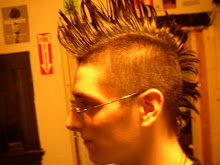The major scales are very useful to playing an instrument. They make it about 12X easier to jam, because you know that all your jammings will be in the same Hz family. Otherwise, it's like going in without a helmet.
Many net teachers show up trying to tell you to do it with "w"s or 1/2 w's or worse, the notes with the little flags. They are Latin. They are no longer a living music language to me. The only music language I speak is circles and numbers, within fretlines. Or fretless number approximations, or plain Hz with an electronic box.
Anybody who doesn't do it this way is selling something, such as Google, who removed my formatting.
N 1 2 3 4
0 x x x 0
1 x x x x
2 0 0 0 0
3 0 x x x
4 x 0 0 0
5 0 0 0 x
6 x x x 0
7 x x x x
8 0 0 0 0
9 0 x x x
10 x 0 0 0
11 0 0 0 x
12 x x x 0
This is the Ionian scale. Play the 0's, do not play the X's.
My friend Jon made a great paper sliding mechanism with dots to show the scales sometime in January. He noted that they look like tetris blocks.
It doesn't matter whether you begin the scale at 12 or at 0, so long it retains its relationship to itself. You can begin at any Hz frequency, so long as it is in relation to the other notes.
Other scales include the Lydian, Dorian, C, A. Note that there are different organizations for 4-string and 5-6 string instruments, called the bass and normal guitar scales. Bass strings are tuned in all-5 relation, while normal guitars are tuned in 4-4-4-5? Or 5-5-5-4 style. This will mess up your rock.
Doing one note at a time within these chords is great, but two at once is sure to make them drip from someplace.
Many net teachers show up trying to tell you to do it with "w"s or 1/2 w's or worse, the notes with the little flags. They are Latin. They are no longer a living music language to me. The only music language I speak is circles and numbers, within fretlines. Or fretless number approximations, or plain Hz with an electronic box.
Anybody who doesn't do it this way is selling something, such as Google, who removed my formatting.
N 1 2 3 4
0 x x x 0
1 x x x x
2 0 0 0 0
3 0 x x x
4 x 0 0 0
5 0 0 0 x
6 x x x 0
7 x x x x
8 0 0 0 0
9 0 x x x
10 x 0 0 0
11 0 0 0 x
12 x x x 0
This is the Ionian scale. Play the 0's, do not play the X's.
My friend Jon made a great paper sliding mechanism with dots to show the scales sometime in January. He noted that they look like tetris blocks.
It doesn't matter whether you begin the scale at 12 or at 0, so long it retains its relationship to itself. You can begin at any Hz frequency, so long as it is in relation to the other notes.
Other scales include the Lydian, Dorian, C, A. Note that there are different organizations for 4-string and 5-6 string instruments, called the bass and normal guitar scales. Bass strings are tuned in all-5 relation, while normal guitars are tuned in 4-4-4-5? Or 5-5-5-4 style. This will mess up your rock.
Doing one note at a time within these chords is great, but two at once is sure to make them drip from someplace.


